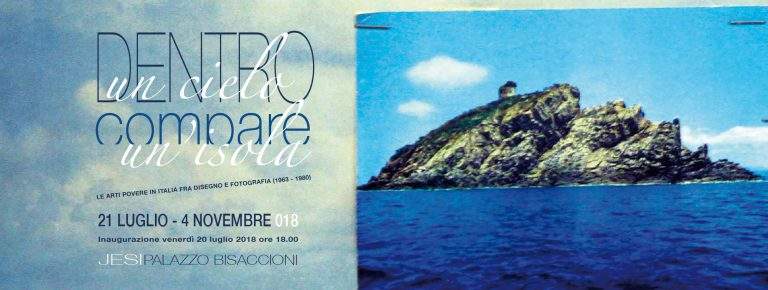The exhibition "Dentro il cielo appare un isola. The poor arts in Italy between drawing and photography (1963 - 1980)," held at Palazzo Bisaccioni in Jesi(Ancona), curated by Andrea Bruciati. This exhibition showcases the works of thirty-two authors to narrate from a particular point of view, that of graphics and photography, an Italian art movement that has had, by critical and market luck, an international echo in the last 50 years:Arte Povera.
It was since the time of Futurism that Italian art had not gone beyond national borders, provoking a cultural resonance that affected all Western countries, so Arte Povera first and then Transavanguardia marked a profound change in artistic language that would influence the development of artistic currents to come.
The works in the exhibition, drawings and photographs made in just over a decade, from 1963 to 1980, represent an act of rebellion against a society dazzled by the economic boom and permeated by consumerism: through research, experimentation and the use of poor media, but with strong communicational connotations artists such as Alighiero Boetti and Vincenzo Agnetti, aim at the recovery of the action, the contingent, the archetype as the only possibility of art.
From the analysis of this decade emerges a new generation of artists capable of reducing the sign to its minimum terms, but where the visual datum always remains fundamental and unavoidable for a possible narration of reality.
It starts from drawing, which for Francesco Clemente, Sandro Chia and Nicola De Maria, is not a preparation for the work, as in minimalist practice, but an autonomous language in which to recover the pleasure of manual skill; or from photography, which for Luigi Ghirri, Mario Giacomelli and Michele Zaza is a personal narrative in real time. In the changed climate of the “years of lead,” the artist seeks to be the spokesperson for an alternative code capable of bringing to light the contradictions of technique and the mystifying arbitrariness of his language, which is therefore iterated, serialized, in a scientific paroxysm where an almost Promethean intent shines through in going beyond the sensitive datum to reveal the connotative structures underlying the work."
The fragility of the media, drawing and photography, becomes the sign of a new sensibility that does not repudiate history nor even the Renaissance figurative tradition that saw drawing practice as a mental procedurality, but reinvents it by loading it with an emotional and conceptual meaning together that it previously did not have.
Thus, at the end of the economic boom, an ’artistic making’ makes its way that wants to exist between the contingent and compromised with the existing: in the recourse to poor materials, art arises as an awareness of the expressive possibilities inherent in the material itself and, in parallel with a progressive radicalization of signs, there is a shift from doing to thinking, from the thing to the Idea. From the agitations of ’68 a generation of artists, exponents of Arte Povera who most embodied the spirit of those years, experimented with a freedom of action linked to the structure of language aimed at redefining a hitherto unacceptable world.
Following this logic, the works of the artists in the exhibition reveal themselves as a kind of attempts and verifications: drawing and photography respond in a new and uncompromising way to a documentary and militant will, as democratic tools of easy access, and at the same time primordial in the ’recording’ of reality as it is, without fiction. On display are works by Vincenzo Agnetti, Adriano Altamira, Enrico Baj, Alighiero Boetti, Sandro Chia, Francesco Clemente, Mario Cresci, Gino De Dominicis, Nicola De Maria, Mario Giacomelli, Luigi Ghirri, Ugo La Pietra, Elio Mariani, Aldo Mondino, Luigi Ontani, Mimmo Paladino, Claudio Parmiggiani, Pino Pascali, Luca Maria Patella, Michele Perfetti, Robert Pettena, Lamberto Pignotti, Michelangelo Pistoletto, Concetto Pozzati, Emilio Prini, Francesco Radino, Sandra Sandri, Mario Schifano, Gianni Emilio Simonetti, Franco Vaccari, Luigi Viola, Michele Zaza.
Opening hours: Monday through Sunday from 9:30 a.m. to 1 p.m. and 3:30 to 7:30 p.m. Free admission. For all information you can call +39 0731 207523, email info@fondazionecrj.it or visit www.fondazionecrj.it.
 |
| Arte Povera stars in an exhibition in Jesi. |
Warning: the translation into English of the original Italian article was created using automatic tools. We undertake to review all articles, but we do not guarantee the total absence of inaccuracies in the translation due to the program. You can find the original by clicking on the ITA button. If you find any mistake,please contact us.